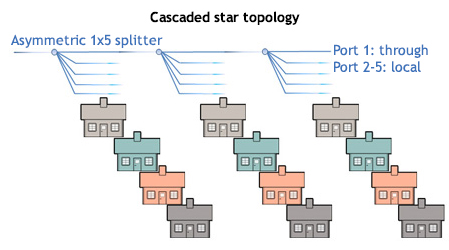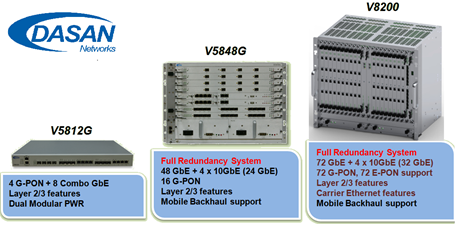All operators offering access telecommunication services, including most importantly Internet access, regardless of the segment they originate from (cable, MSO; internet, ISP; or traditional telephone, Telco) are facing the same challenges and strategic decisions today. These challenges are of course the need to provide increasing bitrate to the subscribers (also upstream), while ensuring network faultlessness and low maintenance costs as well as capabilities of delivering any services, both the ones that exist today (Internet? Television? Telephone? Video-intercom?) and those that can only emerge in the future. The strategic decisions are most of all the choice of technology and a technical partner for network construction.
.png) The traditional media (e.g. telephone and coaxial cable) have reached their limit of capabilities and bitrates, and their life is nowadays being prolonged by more and more complex (which also means expensive and energy consuming) transmission technologies, such as the Docsis 3.1 or the VDSL2 with vectoring. Today, nobody doubts that the final medium is the optical fiber and it’s only a matter of time when it appears everywhere and FTTH (Fiber To The Home) type networks become widespread. Although the above statement is rarely questioned, some people still focus on the issue of fiber-optic network construction costs. A few years ago, these doubts were reasonable, but today the costs of building a fiber-optic network are similar to building costs of networks that use “copper” media (a good quality coaxial cable is today more expensive than a fiber-optic subscriber cable)! Therefore, when building new networks today, there should be no doubts as to what transmission medium to choose. Fiber-optic networks offer all advantages important to every operator:
The traditional media (e.g. telephone and coaxial cable) have reached their limit of capabilities and bitrates, and their life is nowadays being prolonged by more and more complex (which also means expensive and energy consuming) transmission technologies, such as the Docsis 3.1 or the VDSL2 with vectoring. Today, nobody doubts that the final medium is the optical fiber and it’s only a matter of time when it appears everywhere and FTTH (Fiber To The Home) type networks become widespread. Although the above statement is rarely questioned, some people still focus on the issue of fiber-optic network construction costs. A few years ago, these doubts were reasonable, but today the costs of building a fiber-optic network are similar to building costs of networks that use “copper” media (a good quality coaxial cable is today more expensive than a fiber-optic subscriber cable)! Therefore, when building new networks today, there should be no doubts as to what transmission medium to choose. Fiber-optic networks offer all advantages important to every operator:
-vast (and symmetrical!) available band
-very low failure rates
-very low maintenance costs (especially PONs)
-longevity (it is the most “future proof” technology)
Fiber-optic access networks can be built in both point-to-point and point-to-multipoint (PONs) topologies. In point-to-point networks, the whole link from the central to the subscriber is realized on a dedicated fiber. In point-to-multipoint networks, the distribution part is shared by all subscribers, and in their close proximity, the link is divided into dedicated end branches by a passive optical splitter. Disadvantages of point-to-point solutions are higher infrastructure costs, more space required in the central, and higher energy consumption. A natural advantage seems to be the wider available bandwidth per subscriber, but due to bitrate limitation in the uplink ports of central devices, it is usually an illusory advantage. Therefore, the PON technology is definitely the dominating one nowadays, especially with the GPON transmission protocol.
The key component and the heart of each PON is, as mentioned, the passive optical splitter. When using a splitter, up to 128 subscribers can be connected to one port of a central device (OLT). Most frequently in PONs, a star topology or a segmentation with star are used. They both use symmetrical optical splitters. A symmetrical splitter is a splitter that has nominally identical attenuation on all subscriber ports. Symmetrical splitters are the best for dense and multi-family dwelling areas. In areas with sparse housing conditions, or in the case of FTTB (Fiber To The Building) networks, it is worth to consider using specialized asymmetrical splitters, which typically have one selected transit port with a high power and a few identical local ports (although other configurations are also possible). Fibrain as one of a few companies in Europe produces asymmetrical splitters with any power split, e.g. it offers asymmetrical 1x5 PLC splitters dedicated to FTTH network construction in sparse housing conditions.
 The optical splitter, despite being crucial, is not enough for FTTH network construction. A system of passive infrastructure is necessary. It is composed of fiber-optic cables, building cabinets, customer outlets, culverts, taps, and installer devices. One can build such a system from components available on the market, but then it can never be foretold how this “compound” system will cooperate and, most importantly, how it will work in 15 years! In addition, it would be impossible to have a warranty for the whole system, so any technical problems would mean a necessity of inspecting which component (and manufacturer) is responsible.
The optical splitter, despite being crucial, is not enough for FTTH network construction. A system of passive infrastructure is necessary. It is composed of fiber-optic cables, building cabinets, customer outlets, culverts, taps, and installer devices. One can build such a system from components available on the market, but then it can never be foretold how this “compound” system will cooperate and, most importantly, how it will work in 15 years! In addition, it would be impossible to have a warranty for the whole system, so any technical problems would mean a necessity of inspecting which component (and manufacturer) is responsible.
Much more prudent (and often also cheaper) would be using dedicated complex systems of passive infrastructure produced by a reputable manufacturer, which are guaranteed to be thoroughly inspected and operate correctly for years. Fibrain was one of the pioneers of complex FTTH systems on the Polish and European market. Due to a huge experience, today we offer 7 basic systems which are dedicated to all possible investment scenarios:
- FO - system using standard fiber optic cables and closures. Cables with low capacity (number of fibers) are used
- AirTrack - aerial access, based on ADDS cables for short and mid span
- Direct Buried Direct Access Cables - solution based on direct buried cables and/or preinstalled micropipes with cables
- METROJET - microducting system of FTTH application. The microcables used in microducts are installed by air-blowing method
- WET-PATH - system using cables and microducts to place cables in the sewage system
- EAC-R - system based in the (typically) vertically installed, easy access riser cables
- DROP - system utilizing prefabricated and preterminated subscriber kits based on the drop cable
With the versions and possibilities of adjusting to customer needs, the number of possible options increases significantly. We offer the widest range of passive systems on the market, and we are able to choose an optimal solution for any investment. Being the manufacturer of fiber-optic devices, we are also able to modify the system exactly according to your requirements!
A passive network, even built the best way, is of course not enough to provide telecommunication services. To do this, active devices are also necessary, of both central and subscriber types. Fibrain cooperates with main world’s manufacturers in this area. We are technical partners and exclusive distributors of Dasan Networks and BKtel. Dasan Networks is the fourth manufacturer of GPON active devices in the world, and only in Poland we already have performed about 80 implementations. The portfolio of central OLT (Optical Line Terminal) units contains four different types, starting from 1U units of “pizza box” type up to large modular units. Similarly, there are six type of ONT (Optical Network Terminal) subscriber devices available, so every operator should find something adequate to their needs.
 For delivering TV services, FTTH networks offer two possibilities: the CATV, which uses a dedicated wavelength (usually 1550 nm, or the so-called RF overlay, but it can also be 1310 nm) in PAL, DVB-C, DVB-T, or even DVB-S format, and the IP TV. We offer optical CATV devices produced by a renowned German company BKtel, which also manufactures models dedicated for FTTH networks. A central hybrid device BKtel AOT16200, which integrates a 1550 nm CATV transmitter and a 16-port optical 16x20dBm amplifier can be an example. The amplifier enables connecting more than 2000 subscribers with a 1x128 split. The cost per subscriber is in this case a few euros!
For delivering TV services, FTTH networks offer two possibilities: the CATV, which uses a dedicated wavelength (usually 1550 nm, or the so-called RF overlay, but it can also be 1310 nm) in PAL, DVB-C, DVB-T, or even DVB-S format, and the IP TV. We offer optical CATV devices produced by a renowned German company BKtel, which also manufactures models dedicated for FTTH networks. A central hybrid device BKtel AOT16200, which integrates a 1550 nm CATV transmitter and a 16-port optical 16x20dBm amplifier can be an example. The amplifier enables connecting more than 2000 subscribers with a 1x128 split. The cost per subscriber is in this case a few euros!
We have a wide offer for FTTH networks, ranging from an extensive portfolio of passive systems and passive optics to active GPON and CATV devices and the IP TV platform. In addition, we provide design, training, implementing, and measurement services, being able to offer support on all project stages. To obtain more technical information or discuss your requirements, please contact your local sales representative or send us an email to info@fibrain.com.
- Optical Transmission Lexicon: CATV, CWDM, DWDM, FTTH
- PON Technology-Based FTTH Networks for GPON Transmission
- FTTH Networks in Rural Areas and Sparse Housing Conditions
- CATV in FTTH networks
- CWDM Overlay for GPON Networks
- Passive CWDM Solutions
- Passive DWDM solutions
- Multimode GPON Transmission System
- Multimode CWDM Transmission
- Selective Wavelength Filters for Applications in Next Generation Access Networks
